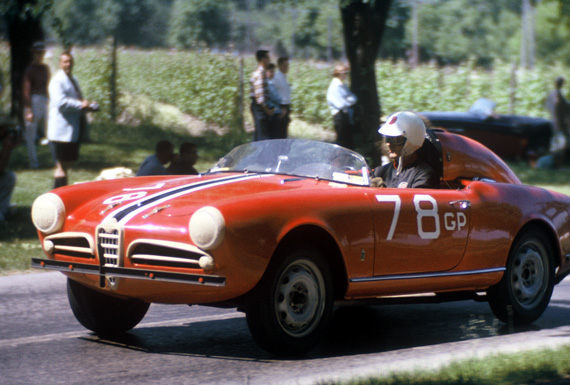
Alfa #78 exits Cemetery Turn with Al Allin at the wheel. Note the fabricated headrest. Collection of Robert Pauley
Color slides courtesy Robert Pauley: Click to enlarge
Text and captions by Carl Goodwin
Chrysler engineer Robert Pauley, who attended the 1957 Cuban Grand Prix, (see review) also made a habit of going to local sports car shows and events. Only 80 miles from his home base in Detroit, Pauley went to Put-in-Bay in 1957 and 1958. The following are his photos taken on Kodachrome slides.
Carl Goodwin was also there, albeit bit younger, and this year finished his book about the event (see review). Pauley’s photos arrived too late to be included in the book, so we present them here, along with informative captions from Goodwin.
Put-in-Bay, June 8th, 1957
The feature race in ‘57 included a couple of Porsche Spyders along with the Lester MG of Ted Jayne and the fast MGTC of Detroit’s Bill Bradley plus several 2-liter production sports cars: ACs, Morgans, Triumphs and then Siatas powered by Porsche and Offenhauser engines. The winner was Tom Payne’s Spyder followed closely by Ted Jayne in the Lester MG.
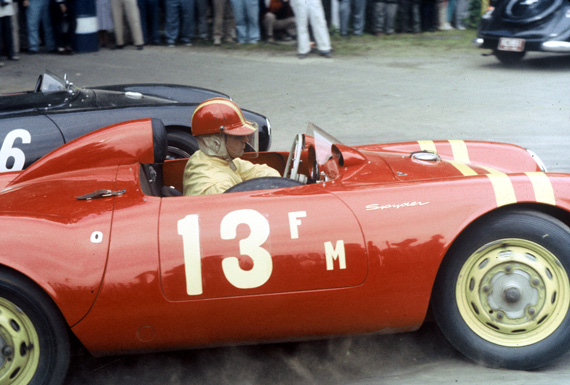
Carl Hass tries an outside pass on the #13 Tom Payne Spyder. Payne’s car number was taken over from Ed Hugus of Pittsburgh. It was also his lucky number. Collection of Robert Pauley
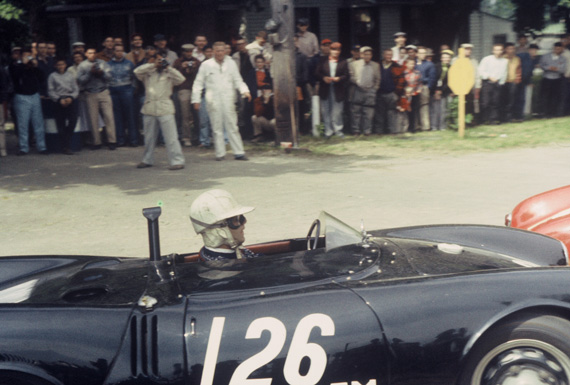
In race 5, the #126 Porsche Spyder of Carl Hass tries an inside pass on Tom Payne’s Spyder. The Haas Spyder is an early high-tail model of the type used in the Mexican Road Race. Payne has the later RS. Collection of Robert Pauley
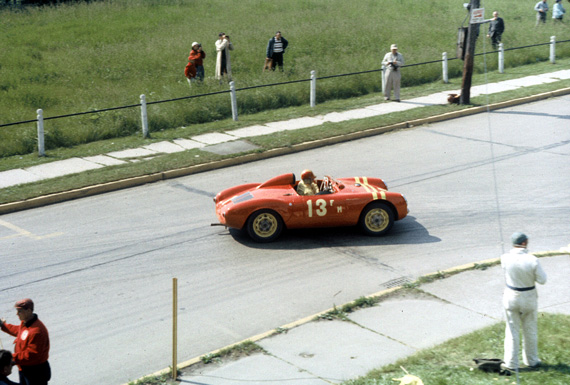
A nice overhead shot of the Tom Payne Spyder from the balcony of the hotel on the corner going into town. This is turn 6, at the Colonial Hotel. Collection of Robert Pauley
Race number four was for F-Production, for cars from 1300 to 1600cc, including MG-As, Porsches and one Volvo, there to promote a Michigan dealership. Though not pictured, the leader of the 10-lap race was the well-known Barnie Burnett from Akron, followed by Ed Hancock of Detroit and Ed Eichenlaub from Ellwood City, Pennsylvania, all in Porsches. The gallant Volvo finished well down in the standings.
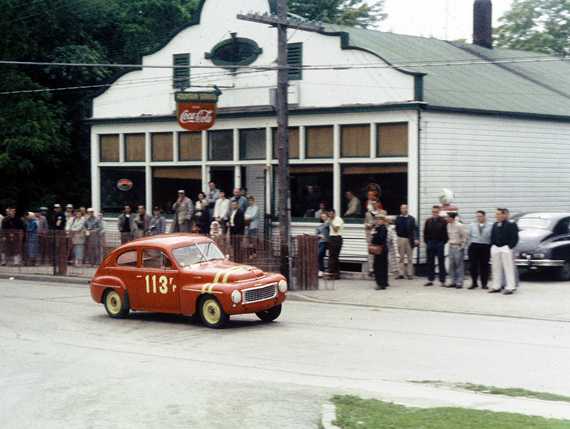
Ypsilanti, Michigan car dealer Tom Payne in Volvo #113 streaks by Tony’s Café at Put-in-Bay on his way to the corner into town. Crossways stripes indicate the Ypsilanti Sports Car, Yachting and Marching Society. June 8, 1957. Credit Collection of Robert Pauley
The most interesting race of 1957 was the Second Race, which pitted the new mid-engined Cooper Bobtail of Tom Hallock against the new Elva Mark II of Chuck Dietrich. We don’t have any Robert Pauley photos of this, so you’ll have to use your imagination. The Cooper had run at LeMans the previous year, driven by Ed Hugus and John Bentley to an 8th overall finish. The Elva had been purchased directly from builder Frank Nichols. It was originally built for the Sebring 12-Hour race but it had no headlights! The pace car was Betty Henn’s XK-140 Jag. The Elva and the Cooper were gridded in the back and, at the green flag, the Cooper led the way up front. Dietrich recalled “We traded places four times until the Elva held onto the lead.”
Put-in-Bay, June 7, 1958
A highlight of the 1958 race was the ten-lap battle between the Alfas of Chuck Stoddard and Ivan Trofimov (pron. “Tro-fee-moff”) in G-Production. It wasn’t just a runaway with Stoddard leading. Chuck started behind Ivan and eventually passed him. Here are a few details:
“Just after I started my dealership,” Stoddard says, “Ivan used to come in to kick the tires and nose around. His father was a cam engineer. Not the engine camshaft kind but cams that actuate machinery. So Ivan decided to get a red Alfa Veloce.
“Then he went to Put-in-Bay with the Alfa. He was a sharp guy and a good driver. At the end of the race, my engine crankshaft broke a short distance from the finish, so I coasted across and took the checkered flag. There’s a picture of this happening and behind me is Ivan’s red car – he didn’t catch up.
“We don’t know of any other races he ever drove and, after 1960, he disappeared. A lot of guys were like that. They would get hyped up and then find it wasn’t so easy. I found that, for every hour on the track, there would be 10 hours of preparation.” [In the 50s and 60s, Stoddard won three SCCA National Championships in Alfas.]
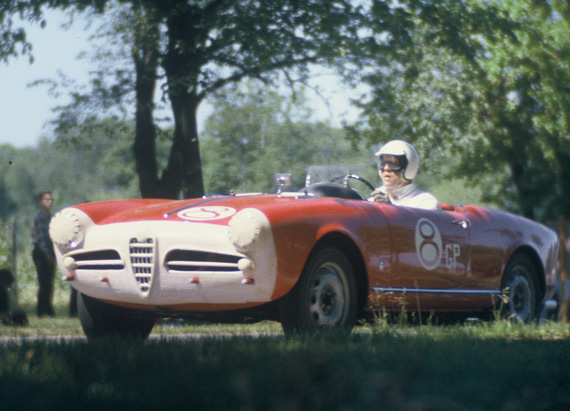
Ivan Trofimov in the Giulietta # 8 sets a fast pace in Race Three. He would finish a close second to the Alfa of Chuck Stoddard. Collection of Robert Pauley
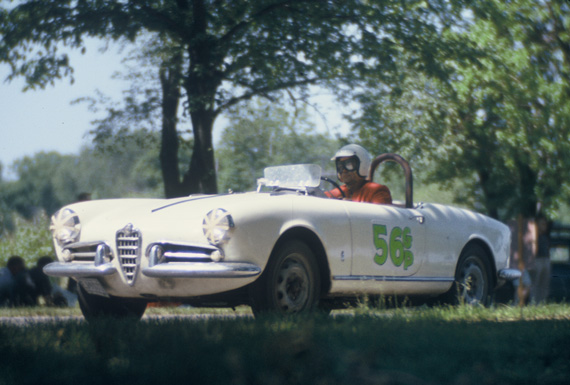
Popular Detroit driver Bill Bradley storms down the course in his Alfa Giulietta. Collection of Robert Pauley
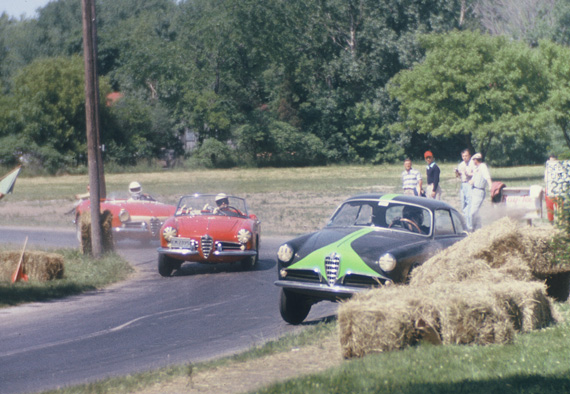
Three Alfas negotiate Airport Corner. The black Sprint seems to be running a bit wide while the two red Alfas are clipping the apex. Collection of Robert Pauley
At Put-in-Bay, the First Race was always the MG race. By 1958, all of the T-series MGs were on the track – TCs, TDs and TFs — and there were 24 of them for this race. The starting grid was full of the most interesting characters. Many had been in recent military conflicts. Ralph Cadwallader had been an infantry officer in the Battle of the Bulge. Chuck Dietrich had been a gunner on a Landing Craft in the Pacific. Charlie Ellmers had flown 33 reconnaissance missions as a radar operator off the aircraft carrier Essex over Korea. At the end of the race, the first four cars were Chuck Dietrich, Charlie Ellmers, Al Weaver and Chuck Henry.
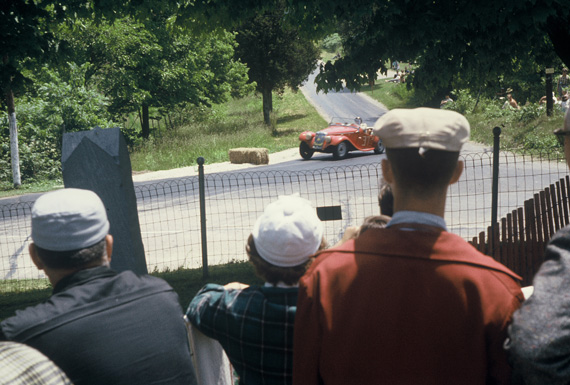
The notorious Cemetery Turn, with its off-camber exit, was the site of many a near miss with the tombstones. Here a red MGTD gets through the turn properly. Collection of Robert Pauley
While the displacement limit for racing cars was 2-liters, for safety reasons, a number of bigger, faster machines served as pace cars at the start. These included Ferrari, Aston Martin, Jaguar and Bugatti. They would take the field around and then duck into the escape road as the green flag was thrown.
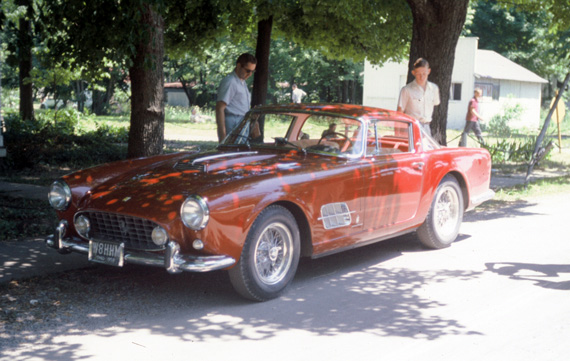
The long wheelbase Ferrari 410 served as a pace care in for the 1958 event. The safer rolling start was dictated by race chairman Dick Henn, in preference to a standing start. Collection of Robert Pauley
At the end of the day, in the Fifth Race, there were three of the new 550RS Porsche Spyders – for Manny Holder, Sidney Baughman and Bernie Keller — and a slew of fast production cars including Bo Miske’s Frazer Nash, the AC Aces of Ben Hall and Ed Lawrence, and two Arnolt Bristols. It was a tight race between Holder and Baughman after Bernie Keller dropped out. Toward the end, Manny Holder was on the pace and was just flying. When the checkered flag fell, he had set a record of 89.9 mph, which is mighty good for a mid-fifties car on a 3-mile course that was basically rectangular. Needless to say, that record will never be broken.
Paradise Lost
Manny Holder also won the feature race in the following year. But 1959 was the last year of the Put-in-Bay Road Races as sanctioned by the Cleveland Sport Car Club (with help from NEOhio Region, SCCA). There were three reasons for this. One is that insurance costs were going up. A spectator had been hit by a race car and was fortunately uninjured. He was hit at low speed by a Sprite, going over the front and down the back. As Chuck Stoddard recalls, the person hit was the insurance agent.
Secondly, the need for Put-in-Bay, or any other road course, was diminishing with construction of several new purpose-built courses. These included Road America in 1955, Watkins Glen in 1956, Lime Rock and Bridgehampton in 1957.
Third, speeds of the cars were increasing as technology moved ahead. In 1952 when the race first started, the 1.5 liter modified cars were MG Specials
whose top speeds were in the neighborhood of 105 – 110 mph. In 1956, when the Porsche Spyders first appeared, they were much higher. Chuck Stoddard estimates that the 550RS of Manny Holder was going 130 mph down Cooper Straight.
After CSCC decided to end the races after 1959, there were many who wanted them to continue and so the 1963 race, organized by the Detroit people (e.g., Waterford Hills), came into being. There was a potentially serious accident when a spectator ran across the course in front of an Elva Mk IV, which crashed into a telephone pole to avoid him. As Porsche guru Vic Skirmants notes, the car hit on the “passenger” side, shearing off the carburetors so that the driver was unhurt. According to race official Jack Holth, “They couldn’t even find the driver. He was sitting at the base of a tree, having a cigarette. That was the end of wheel-to-wheel racing at Put-in-Bay.”
For more on this motor racing Camelot, we urge you to buy a copy of Carl’s latest book, “Put-in-Bay Road Races, 1959-1963. Click here to order
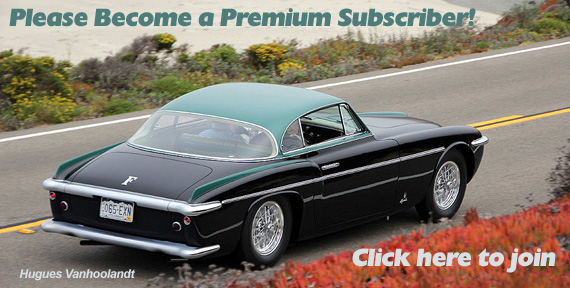
Wow,,,,, great book on such a perfect time, the names and the cars are all the fun. Reading it is like a you-tube video of the beginning of sports car racing in America. The written words and great pictures of the owner/drivers, brings out the thrills that they all must have experienced, in the competition of driving your sports car as fast as you can.
So many neat and exciting people that just flowed into the magic of the world sports car racing of the 60’s.. So glad I was there for at lease some of those early years, can’t begin to count the many life-long friends, …..and life-long memories.
Thanks Carl, with this book you brought us all together again….Tim LaGanke ,, Novelty, Ohio
Great article and color photos show so much more detail of the period! The caption below Tom Payne’s red 550 Spyder indicates that it is the ex-Hugus 550 – is this correct? I am currently doing research on Hugus’s cars and trying to link them all together. Do you have any other information on this car? – thanks Andrew
This is a note to Andrew Hosking. If you read that caption closely, it actually says that just the car number, 13, transferred from Hugus to Payne. During WWII, Ed was a paratrooper in the Pacific. During one of the missions, parachuting behind Japanese lines, Ed was the 13th man out of the plane. Then all the rest were killed, so 13 became his lucky number.
It is still possible that the car might have belonged to Hugus. It was originally a LeMans entry in 1957, driven by Hugus and Carel de Beaufort to second in class and eighth overall. Then it was sold directly to Porsche champion Don Sesslar. The car number was 550-0132 if that helps. I’d be interested in seeing a copy of your list when it’s done. — Carl Goodwin
Thank you, Carl and Pete.!
I first learned of this wonderful event in summer of 1955
complete with Ford Tri motor airplane and a rare Bugatti
on the Ferry, making the journey to Put in Bay, however,
your batch of photographs really make it all come to life
Out west in California we called it Road Racing, but had
just Pebble Beach fore the real thing . we would save up
on money for months to go.
jim sitz
As usual, great tales and great memories from Carl!